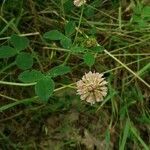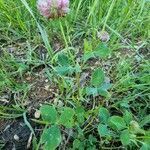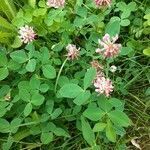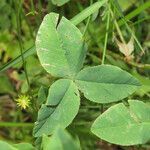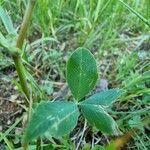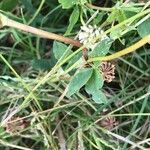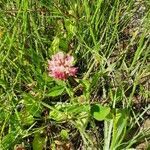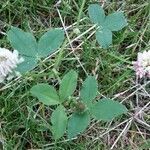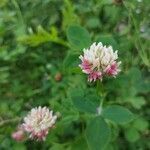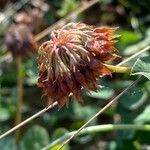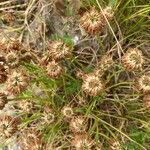Perennial; stems glabrous, erect or ascending, not rooting at nodes. Lvs glabrous; petioles c. 10-100 mm long; leaflets elliptic to obovate, usually obtuse, cuneate at base, finely serrate, c. 10-35 mm long; lateral veins thin and straight to leaflet margin; petiolules up to c. 1 mm long, ± equal; stipules ovate, acuminate. Infls axillary, racemose, globose, pedunculate, > lvs; fls numerous; pedicel up to 6 mm long; bracts subtending fls free. Calyx glabrous or sparsely hairy, 10-veined but 5 veins often indistinct, not inflated at fruiting; throat open, glabrous or sparsely hairy; calyx teeth somewhat unequal (2 upper slightly longer), < corolla, narrowly triangular, usually much > tube, sometimes only slightly >, erect at fruiting; sinuses obtuse. Corolla usually pink, persistent, 5-10 mm long. Pod glabrous, straight, ± = calyx, 3-4 mm long, 1-4-seeded; seeds c. 1-1.5 mm diam.
Ascending perennial 3–8 dm; stipules lance-ovate, their tips free beyond the level of adnation to the petiole; lfls oval to elliptic, broadly rounded to retuse at the summit; heads numerous, globose, on peduncles 2–8 cm; fls 7–10 mm, distinctly pedicellate; cal glabrous, the nerves leading to the obtuse sinuses faint or obsolete; cal-lobes linear-subulate, not very unequal, 1.7–2.5 mm, slightly exceeding the tube; cor white and pink, turning brown after anthesis, the standard obovate-oblong, 2 mm longer than the obtuse wings; 2n=16. Native of Eurasia, escaped from cult. throughout temperate N. Amer., commoner northward. Summer.
Perennial herb, 0.1-0.7 m long; stems erect or ascending, rarely caespitose but with well-developed branches, glabrous. Leaves scattered along stems, long-petioled. Leaflets 10-30 x 10-18 mm, obovate, base cuneate, apex emarginate; margin ± serrulate. Stipules 10-25 mm long, ± obovate, herbaceous, lower third adnate to petioles, apex cuspidate. Inflorescences 10-25 mm in diam., axillary, globular, 10-many-flowered; peduncles slender, longer than petioles of subtending leaves. Flowers white to pink; standard petal ovate-oblong. Flowering time Sept.? Pod slightly exserted from calyx tube, oblong, stipitate, 2-4-seeded.
A herb that keeps growing from year to year. It can lie along the ground or be erect. It grows 50 cm tall. The flowers are white and pink.
